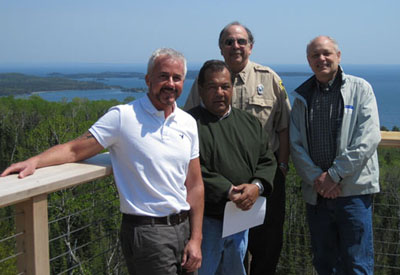By Libby Schultz

From left, Rob Williams, safety rest area program manager, joins his partners from the Grand Portage Tribe, Grand Portage State Park and North Shore Scenic Drive Council at the Mount Josephine Rest Area grand opening ceremony in May. MnDOT file photo |
Minnesota has 54 Class 1 safety rest areas, and even more small rest areas and waysides near scenic overlooks/historical markers. Rob Williams, MnDOT’s safety rest area program manager, collaboratively manages all of them with Central Office and district staff.
“The benefits of safety rest areas are much broader than highway safety,” Williams said. “Safety rest areas support freight movements, promote state and regional tourism and they serve as Minnesota’s and MnDOT’s ambassador to visitors.”
Williams has been with the department for more than 13 years, spending the past eight in his current role as safety rest area program manager.
How is your job rewarding?
My job allows me the opportunity to work with a diverse, dedicated and talented group of people to accomplish day-to-day tasks and long-range planning work. I continue to be amazed at the quality of folks I get to work with in the districts and in Central Office.
Has anything particularly interesting or strange happened at a rest stop?
In the summer of 2009, BlueCross BlueShield hosted an event at a couple rest areas over the Labor Day weekend. The event was part of the unique Do campaign. It involved setting up electronic dance machines at two rest areas. Stopping motorists were encouraged to get their “groove on” and dance to promote health and exercise, and also to ward off driver fatigue. The event was a success and I was happy we supported it.
Have you been to every rest area in the state? Which is your favorite?
I have been to all 54 of our Class 1 safety rest areas, travel information centers and welcome center partnerships. Our Class 1 facilities are what most people consider rest areas, but we have smaller rest areas with more primitive vault toilet restrooms and even smaller waysides that do not offer restroom facilities. These are at scenic overlooks, historical markers or adjacent to rivers, lakes or state parks. I have been to many, but I haven’t managed to see all of the smaller facilities.
I have many favorites and they are my favorites for different reasons. To the dismay of many with whom I work, my favorite is the Straight River safety rest area on northbound I-35 south of Owatonna. Though the building is in poor condition, the architecture truly captures the era in which it was built. The building’s bold geometric shapes along with the “mod” painting and lettering on its exterior announce its mid-1970s origins.
What do you find most satisfying about designing a rest area?
The most rewarding part is the collaboration with project stakeholders. Though it can be demanding, it proves well worth it in the end. In many cases, we have external project partners that we involve in the design process. These have included representatives from cities, tribes, chambers and other state departments like the Minnesota State Patrol and Department of Natural Resources.
How do you decide where to build a new rest area?
We focus our investment recommendations for locations on the Safety Rest Area Service Network. The network includes interstate highways, Minnesota interregional corridors and a few popular summer travel routes with rest areas approximately 50 miles apart.
Over the past decade our focus has been mostly on preserving our current rest areas. In recent years, we have been exploring different spacing intervals, unique partnership opportunities and an electronic customer feedback system, as well as resurrecting the idea of a rest area sponsorship and advertising program.
Do you or a co-worker have an interesting job to share with readers? Click here to send us your ideas, and we’ll contact you for more information.
Recent employee profiles:
|



